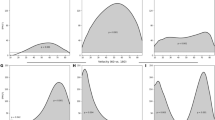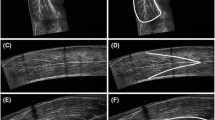Summary
This study assessed the relationship between the isokinetic peak torque (PT) (speed of movement 1.05 and 3.14 rads−1) and the angle-specific torques (ASTs) at 0.26 and 1.31 rad of knee flexion in multiple contractions of the quadriceps and hamstrings in 70 individuals with a chronic anterior cruciate ligament (ACL) insufficiency and 78 individuals with a chronic medial collateral ligament (MCL) insufficiency in one knee. At every test speed, the Pearson product moment correlation coefficients (r) between the PT and ASTs were highly significant (P<0.001) in the uninjured knees (r=0.61–0.93) as well as in the knees with ACL (r=0.61–0.87) and MCL (r=0.74–0.91) insufficiency. In addition, in both groups the majority of the correlation coefficients exceeded 0.80, which is generally regarded as the threshold for the relationship to be considered clinically significant. Furthermore, using regression analysis, both extremities showed completely non-systematic distribution of the residuals. It is concluded that in healthy knees or knees with ACL or MCL insufficiency, the predictability of ASTs from PT was good, and, therefore, that AST analyses may offer little additional information about thigh muscle function to that obtained from a simpler and more commonly used measurement, the PT analysis.
Similar content being viewed by others

References
Baltzopoulos V, Brodie DA (1989) Isokinetic dynamometry. Applications and limitations. Sports Med 8:101–116
Borges O (1989) Isometric and isokinetic knee extension and flexion torque in men and women aged 20–70. Scand J Rehabil Med 21:45–53
Burdett RG, Van Swearingen J (1987) Reliability of isokinetic endurance tests. J Orthop Sports Phys Ther 8:484–488
Burnie J, Brodie DA (1986) Isokinetic measurement in preadolescent males. Int J Sports Med 7:205–209
Charteris J, Goslin B (1986) In vivo approximations of the classic in vitro length-tension relationship: an isokinetic evaluation. J Orthop Sports Phys Ther 7:222–231
Dixon WJ (1983) BMDP statistical software. University of California Press, Berkeley, pp 1–733
Eriksson E (1981) Rehabilitation of muscle function after sports injury — a major problem sports medicine. Int J Sports Med 2:1–6
Fillyaw M, Bevins T, Fernandez L (1986) Importance of correcting isokinetic peak torque for effect of gravity when calculating knee flexor to extensor muscle ratios. Phys Ther 66:23–31
Gilliam TB, Sady SP, Freedson PS, Villanacci J (1979) Isokinetic torque levels for high school football players. Arch Phys Med Rehabil 60:110–114
Goslin BR, Charteris J (1979) Isokinetic dynamometry: normative data for clinical use in lower extremity (knee) cases. Scand J Rehabil Med 11:105–119
Hislop HJ, Perrine JJ (1967)The isokinetic concept of exercise. Phys Ther 47:114–117
Hughston JC, Andrews JR, Cross MJ, Moschi A (1976) Classification of knee ligament instabilities, parts I and II. J Bone Joint Surg [Am] 58:159–179
Järvinen M, Kannus P (1985) Clinical and radiological long-term results after primary knee ligament surgery. Arch Orthop Trauma Surg 106:1–6
Kannus P, Järvinen M (1987) Strength of quadriceps and hamstrings in knees with medial or lateral collateral ligament insufficiency. Scand J Sports Sci 9:79–83
Kannus P, Järvinen M (1989) Prediction of torque acceleration energy and power of thigh muscles from peak torque. Med Sci Sports Exerc 21:304–307
Kannus P, Latvala K, Järvinen M (1987) Thigh muscle strengths in the anterior cruciate ligament deficient knee: isokinetic and isometric long-term results. J Orthop Sports Phys Ther 9:223–227
Knapik JJ, Ramos MU (1980) Isokinetic and isometric torque relationships in the human body. Arch Phys Med Rehabil 61:64–67
Lyon LK, Benz LN, Johnson KK, Ling AC, Bryan J (1988) Qangle: a factor in peak torque occurrence in isokinetic knee extension. J Orthop Sports Phys Ther 9:250–253
Milner-Brown HS, Mellenthin M, Miller RG (1986) Quantifying human muscle strength, endurance and fatigue. Arch Phys Med Rehabil 67:530–535
Moffroid M, Kusiak ET (1975) The power struggle: definition and evaluation of power of muscular performance. Phys Ther 55:1098–1104
Moffroid M, Whipple R, Hofkosh J, Lowman E, Thistle E (1969) A study of isokinetic exercise. Phys Ther 49:735–746
Murray MP, Gardner GM, Mollinger LA, Sepic SB (1980) Strength of isometric and isokinetic contractions: knee muscles of men aged 20 to 86. Phys Ther 60:412–419
Nicholas JJ, Robinson LR, Logan A, Robertson R (1989) Isokinetic testing in young nonathletic able-bodied subjects. Arch Phys Med Rehabil 70:210–213
Perrin DH (1986) Reliability of isokinetic measures. Athletic training 21:319–321
Perrin DH, Robertson RJ, Ray RL (1987) Bilateral isokinetic peak torque, torque acceleration energy, power, and work relationship in athletes and nonathletes. J Orthop Sports Phys Ther 9:184–189
Rothstein JM, Delitto A, Sinacore DR, Rose SJ (1983) Electromyographic, peak torque, and power relationships during isokinetic movement. Phys Ther 63:926–933
Rothstein JM, Lamb RL, Mayhew TP (1987) Clinical uses of isokinetic measurements. Critical issues. Phys Ther 67:1840–1844
Schlinkman B (1984) Norms for high school football players derived from Cybex data reduction computer. J Orthop Sports Phys Ther 5:243–245
Stafford MG, Grana WA (1984) Hamstrings/quadriceps ratios in college football players: high velocity evaluation. Am J Sports Med 12:209–211
Thomee R, Renstrom P, Grimby G, Peterson L (1987) Slow or fast isokinetic training after knee ligament surgery. J Orthop Sports Phys Ther 8:475–479
Westing SH, Seger JY (1989) Eccentric and concentric torque-velocity characteristics, torque output comparisons, and gravity effect torque corrections for the quadriceps and hamstring muscles in females. Int J Sports Med 10:175–180
Westing S, Seger J, Karlson E, Ekblom B (1988) Eccentric and concentric torque-velocity characteristics of the quadriceps femoris in man. Eur J Appl Physiol 58:100–104
Wigerstad-Lossing I, Grimby G, Jonsson T, Morelli B, Renstrom P (1988) Effects of electrical muscle stimulation combined with voluntary contractions after knee ligament surgery. Med Sci Sports Exerc 20:93–98
Williams M, Stutzman L (1959) Strength variation through the range of joint motion. Phys Ther Rev 39:145–152
Wyatt MP, Edwards AM (1981) Comparison of quadriceps and hamstring torque values during isokinetic exercise. J Orthop Sports Phys Ther 3:48–56
Author information
Authors and Affiliations
Rights and permissions
About this article
Cite this article
Kannus, P., Järvinen, M. & Lehto, M. Maximal peak torque as a predictor of angle-specific torques of hamstring and quadriceps muscles in man. Eur J Appl Physiol 63, 112–118 (1991). https://doi.org/10.1007/BF00235179
Accepted:
Issue Date:
DOI: https://doi.org/10.1007/BF00235179



